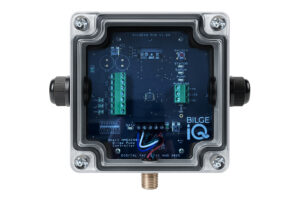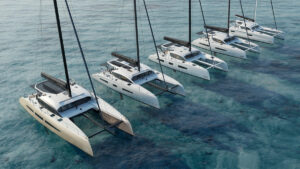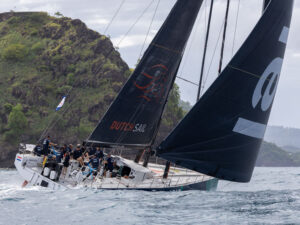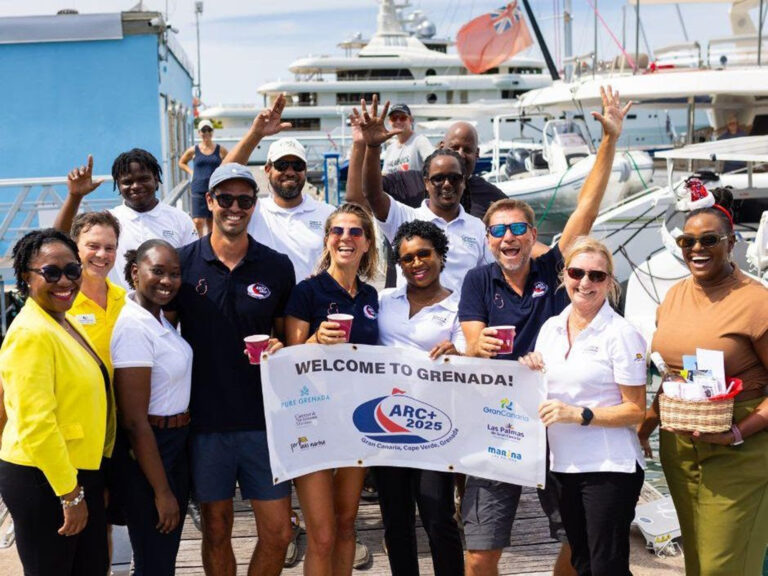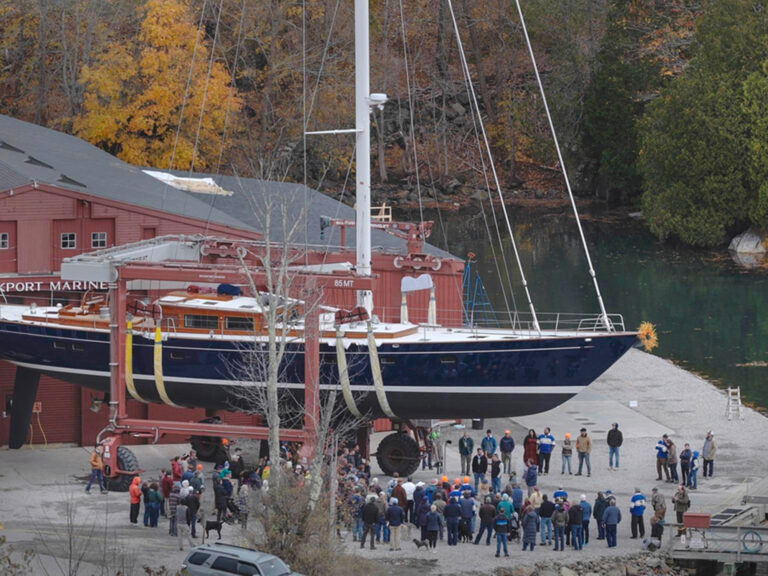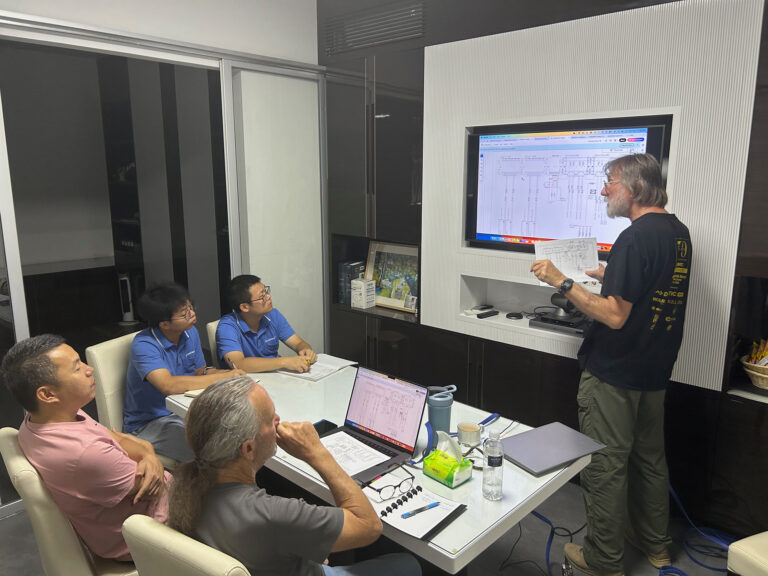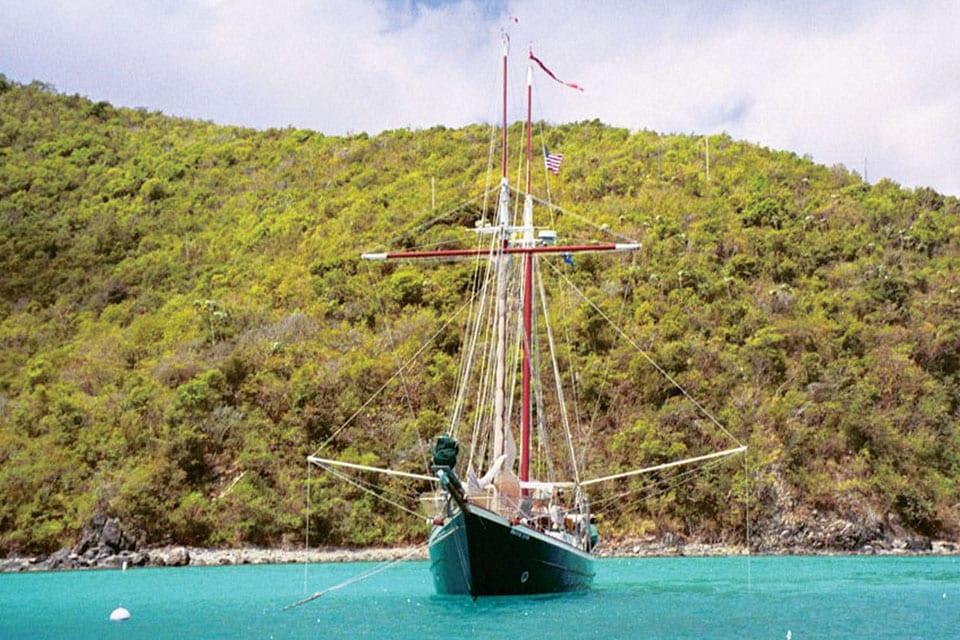
Flopper-Stopper
Lying at anchor in warm and gentle trade winds under a blue sky, Mark and Sandi are enjoying a late afternoon sundowner in an idyllic Caribbean cove. But as Mark fires up the grill, he notices breaking swells over distant offshore reefs.
Their 42-foot cutter is usually very steady, but before long, the boat begins to roll. At first the motion is quite gentle and only mildly annoying, but before long, it increases enough that Mark’s sundowner ends up on the cockpit sole and dinner loses its appeal. Although they’re positioned head to wind, a north swell generated from a weather system hundreds of miles away is wrapping around the small adjacent island and striking them abeam. They decide to deploy their flopper-stoppers to reduce the roll.
At the suggestion of an experienced cruising friend, the couple had installed twin whisker poles that easily stow upright against the mast or on the deck. Although primarily used for poling out the headsails when sailing downwind, they can also be rigged for use with the flopper-stoppers. It’s important to note that Mark and Sandi substantially upgraded the topping-lift lines, the turning blocks on the mast, and the hardware that connects the poles to the spar, which now are all much stronger than those required strictly for sailing. In sudden, severe rolls—such as those created by the wake of a large powerboat—the loads imposed by the stabilizers are immense.
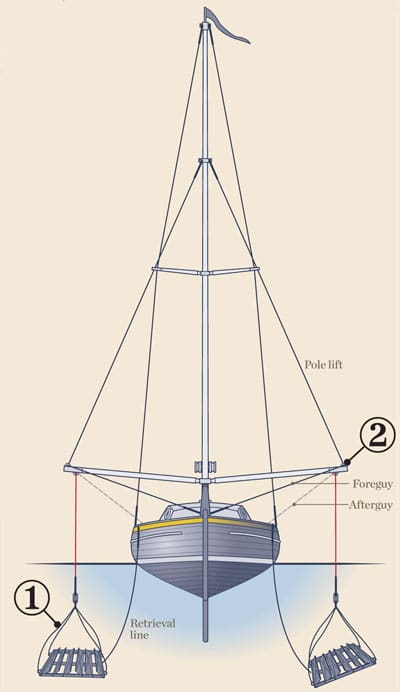
| |
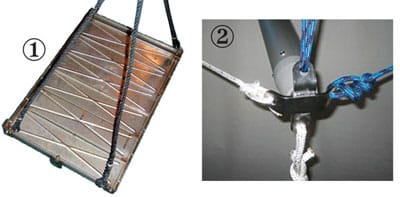
| |How to Deploy a Flopper-Stopper 1. The floppers work together: As one resists the upward motion, the other sinks lower, and the motion of the boat is noticeably and comfortably dampened. 2. The length of the poles is critical and will vary from boat to boat. It’s imperative to have a full understanding of the loads involved. Unlike conventional spinnaker poles, the topping lifts should be secured at the outboard ends of the whisker poles and stabilized by a pair of fore-and-aft guys and by the line that directly secures the flopper-stopper.|
Using the topping lifts that are secured to the ends of the whisker poles (not to the centers of the poles, as with many spinnaker poles), Sandi lowers the poles until they make 90-degree angles with the mast and secures their fore-and-after guy lines to lock the poles perpendicular to the boat’s centerline. Mark retrieves the flopper-stoppers from a cockpit locker and checks that the lines that run from each corner of the device to the connecting ring aren’t tangled.
He secures the first stopper to a line attached to the end of a whisker pole, then ties a retrieval line to a corner of the unit. Next, he lowers the stopper over the side, maintaining a small amount of tension on the retrieval line as the stopper swings out beneath the end of the pole and sinks to a depth of 12 feet. The retrieval line is then secured to a deck cleat with just enough tension to keep the flopper from twisting.
As the first flopper-stopper begins working, the harmonics of the roll are disrupted and the motion is noticeably dampened. After the second unit is deployed, the roll nearly disappears. The baffles work in harmony; as one unit resists the upward motion, the other sinks lower. Mark and Sandi relax and enjoy their dinner, then have a restful night on their gently moving boat.
Floppers vs. Paravanes
The types of stabilizers used when a boat is stationary, as in the preceding example, are very different than those used when a boat is under way. Both are often called flopper-stoppers, but this term is misleading. True flopper-stoppers are designed for use only when a boat is at anchor or, perhaps, drifting. Stabilizers used to ease the motion on an underway boat are properly called paravanes; sometimes these are nicknamed “fish” or “birds.”
Real flopper-stoppers come in a variety of types; while many are homemade, all work on the same principle. They’re designed to sink rapidly, with little resistance, to a depth determined by the connecting line, then resist rapid upward motion, such as that imposed by a wave. Some designs achieve this by shape alone, but most units have baffles that open during descent and close to resist upward motion, or utilize a hinge that allows the unit to drop in a closed position and open when rising.
Many factors contribute to a successful flopper-stopper installation. Several commercial designs on the market provide excellent value because they’ve been fully engineered and the companies that build them offer good technical support. If fabricating them yourself, be sure to have a solid understanding of the forces involved. The length of the poles makes a huge difference. The amount of load placed on the rig is governed by the surface area of the stopper and the length of the pole. A relatively small change in the pole length can have a huge effect on the loads imposed on the rig.
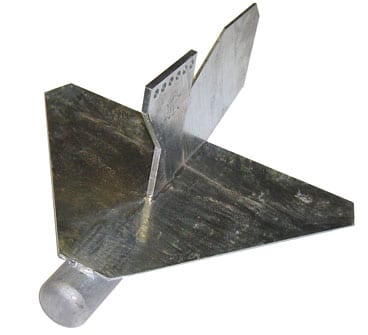
| |**Flying a “Bird” ** Unlike flopper-stoppers, paravanes, or “birds,” are lowered to reduce the roll on a vessel that’s under way. When properly deployed, they “fly” through the water at a downward angle.|
On the other hand, many fishing vessels, trawler yachts, and the occasional motorsailer use paravanes to ease their motion when under power. Paravanes are triangular metal wings with small vertical fins on top, to which a lift/towline is attached, and weighted bottoms, to help keep the wings horizontal as they move through the water. They’re lowered from and towed by structures that extend out from each side of the boat. While they can somewhat reduce rolling when the vessel is stationary, they’re very effective when the boat is under way and they “fly” through the water with a slight down angle that continuously resists upward motion.
Real-World Examples
To use flopper-stoppers on Bonnie Lynn, the 57-foot offshore schooner that my wife, Bonnie, and I launched in 1998, we installed 18-foot aluminum poles that we had specially fabricated for the purpose. We experimented with several types of stoppers, finally settling on a pair of stainless-steel trays that utilize opening and closing baffles. Because the poles are attached at either side of the rig of Bonnie Lynn, which has a beam of 15 feet 6 inches, when the floppers are deployed, they’re almost 52 feet apart. If we used shorter poles, we’d need larger floppers. We’ve used our floppers often in the eastern Caribbean, and they work great.
Since we had the poles and the rig in place, we decided to experiment further and designed and fabricated a pair of aluminum paravanes that were smaller and lighter—12 pounds apiece—than the standard size usually deployed on power vessels. For the bottom weight, we used lead in a streamlined tube. They came in handy on several windless days while we motored through swells. We also tried them while sailing, although rolling usually isn’t a problem unless you’re sailing downwind. When deployed at 7 knots, our speed was reduced to 6.5 knots: not a bad trade-off for the comfort.
Especially when the poles are long, using flopper-stoppers in a crowded anchorage can be problematic. At night, we always illuminate ours with small LED lights so that passing boats can see both the pole and the lines. The proper depth and pole angle will vary by boat and conditions. The units should never be allowed to touch bottom, but they must be set deep enough so they aren’t affected by waves or turbulence from beneath the boat.
While there are many good references on the subject, most focus on flopper-stoppers for powerboats, although the principles are the same. An enormous help to us was Captain Robert Beebe’s Voyaging Under Power; originally published in 1975, it’s been recently updated and is available online.
If rolling anchorages have been a problem, give flopper-stoppers a try. You won’t be disappointed.
Earl MacKenzie holds a U.S. Coast Guard 500-ton ocean master license and skippers the charter schooner Bonnie Lynn (www.bonnielynn.com).
For More Information
The following companies manufacture commercial-grade flopper-stoppers (also known as roll stabilizers) and/or paravanes: Forespar, Kolstrand, Magma Products and Prime Fabrication, Inc.
This article first appeared in the May 2013 issue of Cruising World.


